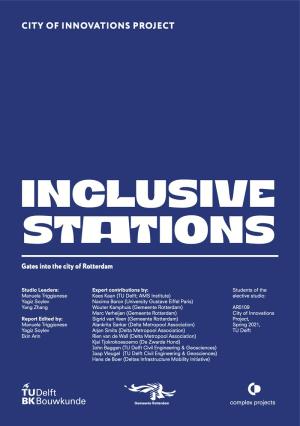Hosted by
INCLUSIVE STATIONS: Gates into the city of Rotterdam
Synopsis
In the Dutch National Environmental Vision 2021, new living and working locations are mapped on existing urbanized sites - mainly at catchment areas of public transportation (PT) nodes or stations [1]. This is the case in the metropolitan area of Rotterdam, where new developments projects are taking place at several station locations. In the Rotterdam Mobility Plan [2] “inclusiveness in mobility” is emphasized by setting several objectives for a PT node. These objectives address the mixití© of facilities and attractiveness at station locations with public spaces, accessibility with more bikes (and sustainable modes of transport) and fewer cars in the city centre [3]. How could the station as a node respond to future challenges of seamless travel, inclusivity and the changing intensity of cars and pedestrian flows both in the centre and the periphery of the city of Rotterdam? The following pages intend to answer this question through the narrative of six research-by-design projects, conducted by the students of Complex Projects group and enrolled in “City of Innovations Project” elective, “Inclusive Stations’’.
Working in close collaboration with the City of Rotterdam, teachers and design professionals, the students were asked to reflect on the importance of transport networks within and extending from the city. Through considering the way these networks have shaped the city by weaving the urbanites of the city center(s) and suburban areas, this elective has been focused on three station locations which act as gateways to the city center of Rotterdam: Meijersplein Airport station, Rotterdam Alexander rail-metro station and Slinge metro station. The ‘6 Visions X 3 Locations’ chapter is a systematization of the work of 27 masters students with input from designers of the City of Rotterdam, Delta Metropool Association and De Zwarte Hond. The research-through-design process consists of documenting and analysing the present urban conditions of selected station locations and proposing design solutions and visualisations of the development of these locations. It shows the methodology of the process that sees the interaction between students-teachers-professionals on a weekly basis through thematic workshops, lectures and site visits in Rotterdam.
The elective “City of Innovations Project - Inclusive Stations’’ is connected to current research and design studios of Complex Projects group at the Department of Architecture dealing with the role of infrastructure as a catalyst of urban developments. This output is a follow up of recent publications by Complex Projects, such as: “Living Stations” (2020), “Amsterdam 2050” (2019) and “Stations as Nodes” (2018) published by TU Delft open.
[1] More info: https://www.novistukken.nl/english/default.aspx
[2] More info: http://tda-mobility.org/wp-content/uploads/2018/11/Rotterdam_Urban-Traffic_Plan.pdf
[3] Triggianese, M. (2021). Stations as a lever for inclusive growth. In M. Triggianese, O. Caso, & Y. Sãylev (Eds.), Living Stations: The Design of Metro Stations in the (east flank) metropolitan areas of Rotterdam (pp.8-13). TU Delft Open.

